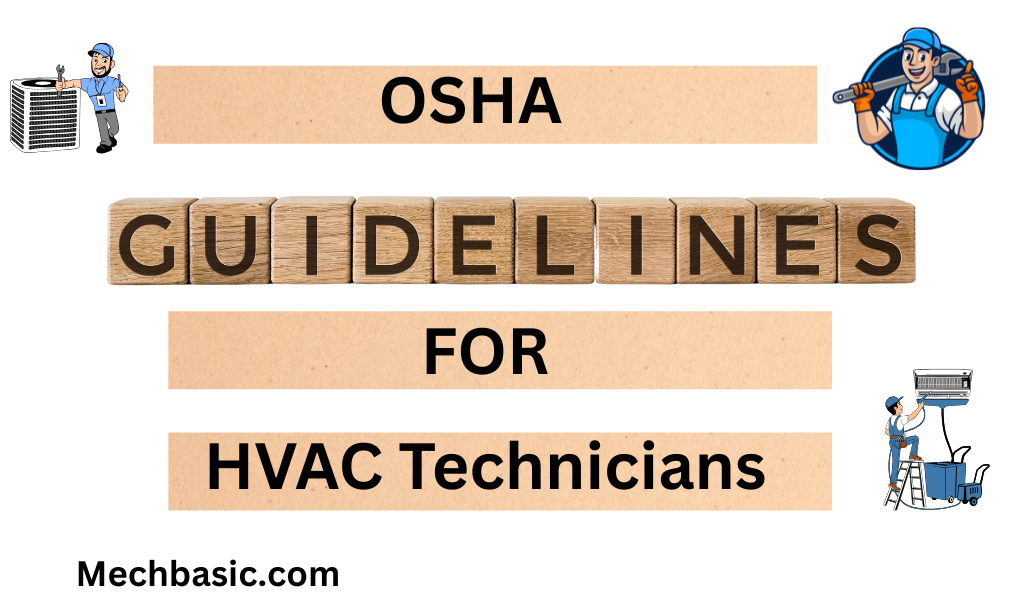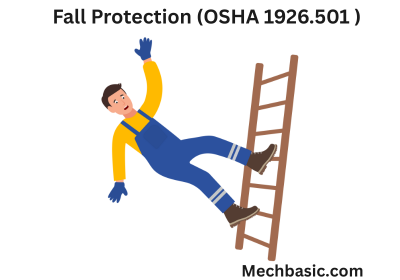The Occupational Safety and Health Administration (OSHA) enforces workplace safety standards to protect HVAC technicians from hazards like electrical shock, refrigerant exposure, falls, and confined spaces.
Compliance with OSHA guidelines ensures a safe working environment and reduces the risk of injury or illness.

In this article:
What is OSHA Safety Guidlines in HVAC?
OSHA and HVAC: OSHA (Occupational Safety and Health Administration) regulates HVAC safety standards to protect workers from hazards like refrigerant exposure, electrical risks, and poor ventilation. Compliance ensures safe installation, maintenance, and operation of HVAC systems.
Why OSHA safety Guidelines are important?
It’s important because OSHA HVAC standards help prevent workplace injuries, illnesses, and fatalities caused by electrical shocks, toxic refrigerant leaks, poor air quality, or improper equipment handling.
Following these regulations ensures a safer work environment and reduces legal and financial risks for employers.
1. Common OSHA Hazards in HVAC Work
- ✅ Electrical Hazards – Shock, arc flash, and faulty wiring.
- ✅ Chemical Exposure – Refrigerants, solvents, and cleaners.
- ✅ Fall Hazards – Working on ladders, rooftops, and in attics.
- ✅ Confined Spaces – Crawl spaces, ducts, and mechanical rooms.
- ✅ Lockout/Tagout (LOTO) – Preventing accidental equipment startup.
- ✅ Personal Protective Equipment (PPE) – Required safety gear.
2. Key OSHA Regulations for HVAC Technicians
A. Electrical Safety (OSHA 1910.333 & 1910.335)
- 🔹 Always de-energize equipment before servicing.
- 🔹 Follow Lockout/Tagout (LOTO) procedures to prevent accidental power restoration.
- 🔹 Use insulated tools and wear rubber gloves when working on live circuits.
- 🔹 Keep panels & junction boxes covered to prevent accidental contact.
📌 Tip: Use a multimeter to verify power is off before touching any electrical components.
B. Refrigerant Safety (OSHA 1910.1200 – Hazard Communication)
- 🔹 Follow EPA Section 608 regulations for refrigerant handling.
- 🔹 Wear safety goggles & gloves when working with refrigerants.
- 🔹 Ensure proper ventilation when recovering or charging refrigerants.
- 🔹 Use leak detectors to check for refrigerant leaks.
📌 Tip: Never vent refrigerants into the atmosphere—use approved recovery machines.
C. Fall Protection (OSHA 1926.501 – Fall Prevention Standard)
- 🔹 Use harnesses and fall arrest systems when working on rooftops.
- 🔹 Secure ladders properly and ensure stable footing.
- 🔹 Install guardrails or warning lines around open roof areas.
- 🔹 Never step on unstable surfaces like ductwork.
📌 Tip: If working above 6 feet, OSHA requires fall protection gear.

D. Confined Spaces (OSHA 1910.146 – Permit-Required Confined Spaces)
- 🔹 Identify permit-required confined spaces (crawl spaces, attics, mechanical rooms).
- 🔹 Test for oxygen levels & hazardous gases before entering.
- 🔹 Have a spotter or ventilation system in place.
- 🔹 Use a harness and retrieval system when required.
📌 Tip: Avoid prolonged work in hot attics to prevent heat exhaustion.
E. Lockout/Tagout (LOTO) – OSHA 1910.147
🔹 Always shut off power and use LOTO devices before servicing.
🔹 Never bypass safety switches or relays.
🔹 Tag equipment clearly to prevent accidental startup.
📌 Tip: Use LOTO kits with padlocks and warning tags on HVAC panels & breakers.
F. PPE (Personal Protective Equipment) – OSHA 1910.132
- ✔ Safety glasses & goggles – Protects against debris and chemicals.
- ✔ Insulated gloves – Prevents electrical shock.
- ✔ Respirators – For working in dusty or poorly ventilated areas.
- ✔ Hard hats – When working in construction zones or under heavy equipment.
- ✔ Steel-toe boots – Protects feet from falling objects.
📌 Tip: OSHA requires employers to provide PPE and ensure it’s used properly.
3. OSHA Compliance & Best Practices
✅ Keep safety training up to date (fall protection, electrical, chemical handling).
✅ Use proper lifting techniques to avoid back injuries.
✅ Follow manufacturer guidelines for servicing HVAC systems.
✅ Report hazards immediately to supervisors.
Frequently Asked Questions:
1. Why does OSHA regulate HVAC work?
Answer: To protect workers from hazards like refrigerant exposure, electrical shock, and poor ventilation.
2. Do HVAC technicians need OSHA training?
Answer: Yes, especially OSHA 10 or OSHA 30 training, depending on the job site and role.
3. What are common OSHA violations in HVAC?
Answer: Lack of PPE, improper lockout/tagout, poor ladder safety, and inadequate ventilation.
4. Is handling refrigerants an OSHA concern?
Answer: Yes, due to chemical exposure risks—OSHA requires proper training and safety procedures.
5. How can HVAC companies stay OSHA compliant?
Answer: Provide safety training, use PPE, follow lockout/tagout, and maintain up-to-date safety protocols.
Other Courses:



